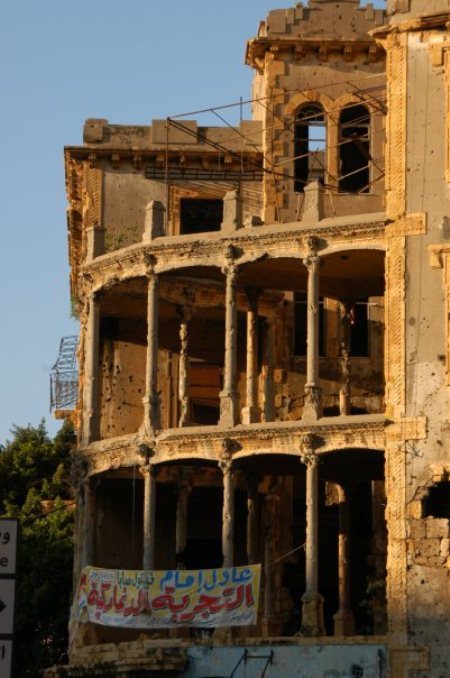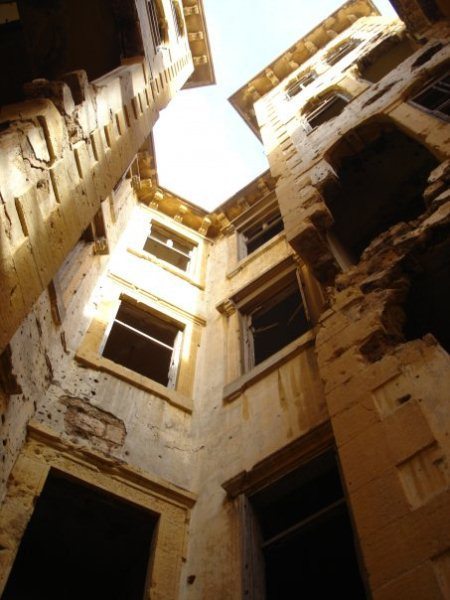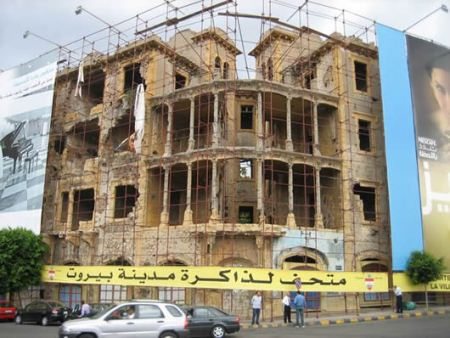Beirut’s yellow house
Located in the district of Ashrafieh, the Yellow House, also called the Barakat Building (named after its former owners), is both an architectural landmark and a historical symbol of life in Beirut. Marked by its history, the building is at the heart of a regeneration project that will transform it into a museum of the history of the city of Beirut and an urban cultural centre. It is an innovative project which deals with critical urban issues.
The Yellow House, symbol of a turbulent history
Built in the 1920s, the Yellow House is surprisingly original. Architect Youssef Aftimos used a combination of natural stone and concrete. While its yellow colour is due to the coating used for most of the buildings constructed at that time, what makes it unique is its three-sided facades as well as its 180-degree views. Because of this feature, Aftimos is considered a pioneer in his field. Bourgeois life of the era has left its mark on the building, including the presence of secondary staircases built so that the maids would not cross the family’s living area.
The Yellow House was to play a strategic role during the Lebanese Civil War, which broke out in 1975 and lasted 15 years. During the war, there were two areas in Beirut — East and West — separated by a demarcation called the Green Line, in reference to the greenery that surrounded it. The Yellow House is located at what was the centre of this ‘no man’s land’ between Christian militias and Palestinian-leftist forces. It therefore became a strategic landmark for militiamen, who quickly took over the building. They became known as the ‘snipers of Barakat’. A single room could be occupied by three shooters to sweep the area. From that time on, the building which had once stood as a symbol of secular Lebanese plurality — where Christians, Muslims, Palestinians and Armenians lived together — was left abandoned.
The Yellow House at the heart of the debate over the preservation of Lebanese heritage
When the guns finally fell silent, years went by without any public acknowledgement of what had happened — no memorial, museum or public space was dedicated to the commemoration of the war years. Instead, Beirut’s inhabitants fell into a collective amnesia. Beirut, a city “dead a thousand times, relived a thousand times” as poet Nadia Tueni once wrote, suffered from a ‘dubaïfication’ and from a fashionable modern homogenisation as towers grew taller and taller. Only a few skeletons of buildings devastated by the war were still visible, but for a long time no action was taken in order to preserve them.
Once again, the Barakat Building stood as a symbol, this time as a haunting reminder of the Green Line and the division of the city: and in order to erase the past (the better to forget it), it was at one time under threat of being demolished. Architect Mona Hallak and others firmly opposed this. A debate on the preservation of Lebanese heritage eventually emerged. Finally, in 1998, the building became the property of the municipality of Beirut and its destruction was suspended. Artist Rita Aoun, who had spent hours in the devastated apartments littered with pieces of mortar and sand bags, was the first to transform the building into a place of memory: “Every second, memory is created,” she argued. “When you destroy a building, memory is destroyed to create that of the future. The question is, what memory will we leave to our children?”
An ambitious restoration project: Beit Beirut, Museum and Urban Cultural Centre
A few years later, in 2006, a restoration project was started, after the signing of a Memorandum of Cooperation between the cities of Beirut and Paris. The Barakat Building was to become a Museum of the History of the Lebanese capital and home to a library dedicated to urban issues and an Urban Observatory — a research centre on the city and an auditorium with 200 seats. The project revolves around a reflection carried by many architects, psychologists and intellectuals on the preservation of buildings and other artifacts damaged by war.
At the official launch party of the project, the mayor of Paris Bertrand Delanoë announced that “the architectural work is organised around the respect for the traces of the past, conservation, and the reconstruction of the building,” adding that the museum was scheduled to open in early 2013. The goal is to strike a balance between the past and modernity, between heritage preservation and technological innovation, favouring “the emergence of a new image of the city contributing to the national and international prestige of the capital,” as Abdel Mounem Ariss said, then-President of the Municipal Council of Beirut.
To reflect the role and place of the future museum and cultural centre Beit Beirut (the House of Beirut), the Cultural Office of the French Embassy in Beirut, the Beirut Municipality, the City of Paris and the IFPO (French Institute of the Middle Near East) have combined their skills. Museum professionals meet regularly at round tables to develop an outline of the project. Jean-Marc Leri, director of the Carnavalet museum, emphasises the importance of the building as a place of conservation which would preserve memory. He highlights the parallel with the Carnavalet museum dedicated to the history of the city of Paris created following the massacres of the Commune, which destroyed nearly a quarter of the Parisian heritage. For him, the museum’s goal is to preserve in order to remember. Because of this, it seems essential to “keep as much as possible the marks of war that can still be seen on the facades, [such as] these walls riddled with bullets.”
Beatrix Goeneutte, director of the Maison de Banlieue et de l’Architecture outside Paris, insists on the importance of Beit Beirut’s educational role and the vital importance of encouraging public interaction with the space. Historical resources and tours will be offered to allow the public to better understand the historical, cultural and urban environment of Beirut. Claire Calogirou, researcher at the National Centre for Scientific Research and head of the Research department at the Museum of Civilisation in Europe and the Mediterranean also believes that Beit Beirut should serve as a public space and engage its visitors as much as possible. To this end, the planners envisage an archive accessible to the public on site, in addition to a center for digital data. Beit Beirut will also host a part of the Arab Image Foundation’s photograph collection, for which they had previously had difficulty finding a suitable home.
A genuine exchange platform and a place of public debates open to all, the project aims to familiarise Beirut’s civil society to urban and heritage issues through the rediscovery of the city and its history. The project has triggered a profound reexamination of Beirut’s policies regarding the preservation of its architectural heritage, and by extension, the preservation of its identity.
This article was published with the courtesy of LIBALEL.
4 thoughts on “Beirut’s yellow house”
Leave a Reply
You must be logged in to post a comment.










Great article.
http://spatiallyjustenvironmentsbeirut.blogspot.com/2011/06/barakat-building-public-green-space.html